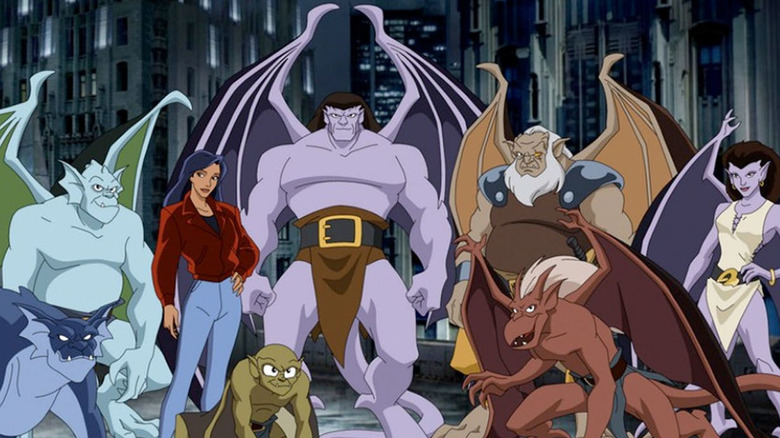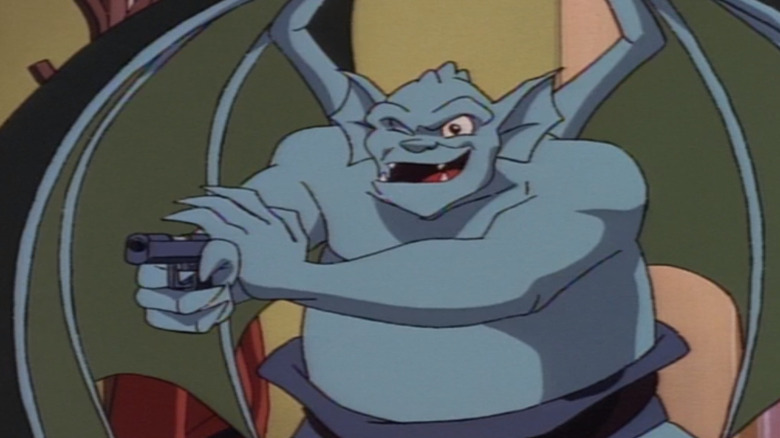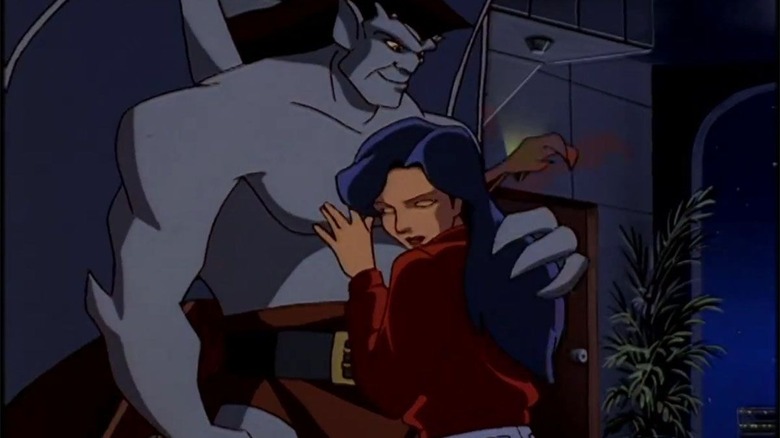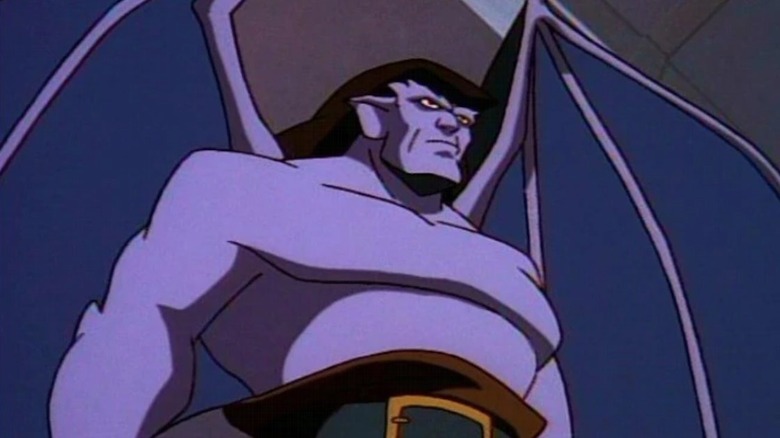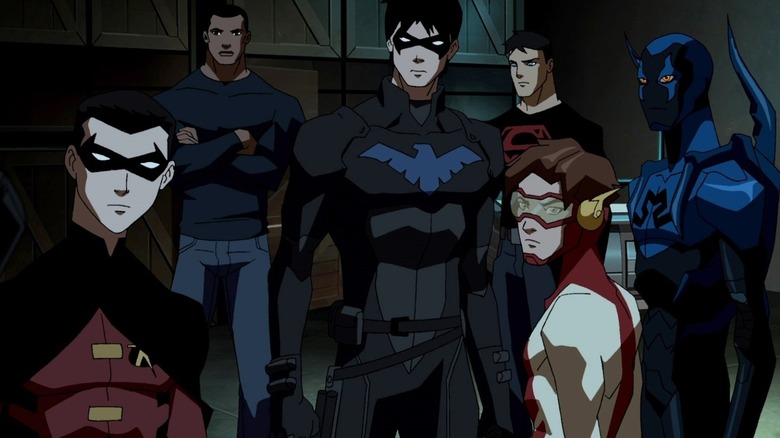Gargoyles Creator Greg Weisman On Bringing Back The Story In Comic-Form, The Future Of Young Justice And More [Exclusive Interview]
"We are defenders of the night. We are Gargoyles!" so begins every episode of the acclaimed '90s cartoon "Gargoyles," which even today feels like a miracle of television. A show with dense lore, complex and mature themes, a serialized story that nevertheless understood the importance of a good standalone episode and simply breathtaking action, "Gargoyles" was and remains like no other show.
Created by Greg Weisman for Disney Television Animation back in 1994, "Gargoyles" follows sentient, humanoid creatures with bat wings who get frozen in stone during the day. They once protected a medieval Scottish castle, until a betrayal killed most of them and froze the rest — who awoke in modern-day Manhattan. The show felt like a fantasy take on the "X-Men," with mythologies from all over influencing its deep lore, including Norse mythology and Arthurian legends, while a healthy dose of Shakesperean influence gave the story gravitas.
The show lasted for three seasons — though the third one is vastly different and mostly ignored by fans and the creators alike.
After many, many years, the Gargoyles are finally back. After Disney+ helped breathe new life into the franchise, the story continues following the events of season 2, as a comic book thanks to Dynamite Entertainment. Issue number 2 goes on sale January 25, 2023.
/Film talked with "Gargoyles" creator Greg Weisman about the making of the iconic cartoon, bringing it back in comic-book form and finally continuing the story, as well as the status of "Young Justice" and more.
Sequential and full of consequences
The original "Gargoyles" was a unique cartoon for its time. It had a tone and more mature storylines than most shows of the time, prioritizing character drama and mood over wacky situations that could catch children's attention.
The show is perhaps best remembered today for its serialized storytelling, which deepened the characters and the lore with each episode. This was a decade before "Avatar: The Last Airbender" — yet, "Gargoyles" had equally as epic a story as either of those shows.
If you ask Greg Weisman, however, he doesn't consider the show's use of serialization all that special. He considers all modern TV, from "The Sopranos" and "Rick and Morty" to "Gargoyles" and "Game of Thrones," derivatives of the one show that created the modern format: "Hill Street Blues." The 1981 cop show was unique for its use of handheld cameras and intertwined storylines that were told across multiple episodes. What Weisman and his team on "Gargoyles" did was somewhere in the middle, having episodes that were still standalone and had clear beginnings and endings, while still building up to a larger story.
"What we called our show then was not serialized. We thought of it as episodic, but sequential. And the second word is what made it different. In other words, you can tune into any episode, but you're going to get more out of it if you watch them in sequence."
This makes a huge difference. Having each episode work on its own makes "Gargoyles" re-watchable, because you can start at any point and understand at least that specific chapter of the story — unlike something like "Game of Thrones" — while still having each episode build into the next one so they are all meaningful parts of the larger story.
The sequential format also helps the show have consequences, something that was solely missing from animated shows of the time, and has been arguably one of the biggest revolutions in TV animation over the past decade or so. We see characters grow and change over time, actions, be they fights or arguments, had consequences that affected the characters' relationships. Take one of the most famous storylines of the show — Broadway accidentally shooting Elisa with her own gun.
The shooting causes Elisa to be badly hurt and almost bleed to death. The following episode picks up weeks after and she is still in recovery, which lasts for a few episodes and deeply affects both characters. "Everyone was behind us in doing that story," Weisman explained. "It seemed like an important story, and it was imitative behavior because kids can, in theory, find their parents' guns or whatever and do something horrible with them. But the point was, we were showing the repercussions of this."
Cliff falls and Star Trek actors
According to Weisman, the fact that "Gargoyles" was a first-run syndicated show meant they had different standards and fewer studio notes than if the cartoon aired on a network. This allowed the show to have violent action and kill off characters, though the studio definitely had some thoughts on the manner in which the characters died.
As Weisman told us, during the episode "City of Stone," two villains die. One falls off a cliff, so when it came time to kill the other villain, there was an issue with how to depict it responsibly.
"We didn't want to just have him fall off another cliff because at that point, it just felt repetitive," the animator said. "There's no dramatic purpose to have him fall off the cliff." And yet, an executive at the studio didn't want the character to just get stabbed because that is imitable behavior. So, the writers came up with a magic sphere that Macbeth tosses to the villain and causes him to combust.
"That was great because it was a magical death, so not imitable, but then we had a problem, which was that it was so extreme, what do we do with the corpse? So we had the corpse fall off a cliff. And [the studio exec] was like 'well, falling off a cliff, that's what I said in the first place!' I'm like, yeah, but it's not the fall that kills him. It was the magical sphere that kills him. We just used the fall to get them off stage, get them off screen."
One thing that "Gargoyles" was famous for was having a big "Star Trek" cast, with nine members of the cast being shared between both franchises. According to Weisman, the crew were huge fans of the sci-fi franchise, but the casting was mostly a coincidence, serving as inspiration for them to think of new actors to reach out to. That being said, there was one "Star Trek" actor they tried to bring over to "Gargoyles" that unfortunately never panned out.
"We talked about Patrick Stewart for a handful of roles, and that didn't work out," Weisman said. The problem is that Stewart's representatives asked for more money, and the show's "favored nations" contract that meant all actors got the same level of salary, so a guest star could inflate the voice budget out of the water.
Bringing the gang back together
Now, 26 years after the show's initial run, Greg Weisman is back to continue the story of the defenders of the night. The new comic, published by Dynamite Entertainment, picks up where the popular cartoon ended, continuing the story told in the '00s comic published by SLG and Creature Comics, and introduces an unhatched Gargoyle egg that can change the Gargoyles forever.
When we last saw them, the Manhattan clan of the Gargoyles had expanded from 6 to 14 members, and their longtime adversary Xanatos is now kind of an ally as well. The first 12 issues of the comic (Weisman is hopeful there will be more if sales are strong) tell one big story set in Manhattan in the spring of 1997. Because of how the limited space in comic form, Weisman warns readers that some of their favorite characters won't appear in this part of the story.
"The clan is 14 members, that's too many people for George [Kambadais] to draw page after page after page," Weisman explained. Instead, he had to choose four Gargoyles that would go on this adventure to see the birth of a new Gargoyle, while the rest stayed behind. The animator and writer has been coming up with new "Gargoyles" stories ever since the show went off air, following all sorts of characters across different timelines — including an Arthurian story with Arthur and Griff looking for Merlin in the year 600. Though we don't see the entire cast this time around, Weisman is planting seeds for more stories beyond the initial 12 issues.
A heroic coming-of-age story
After developing "Gargoyles," Weisman also worked on developing another cartoon with a huge cast, sequential stories, and meaningful action that had consequences for the characters: "Young Justice."
This is a show that truly captures what it is like to read epic comic-book storylines with lots of tie-in issues that bring multiple characters and stories together. What started as a story of three sidekicks wanting some darn respect from the superhero community evolved into a multigenerational epic spanning a full decade, hundreds of characters, dozens of locations and worlds, and as many continuous storylines. Weisman credits the fact that they started out small with "Young Justice" being able to sustain such a large cast later on. "You slowly but surely build the cast and you create a world and you make the world real because it's filled with real characters."
Because the show takes place almost in real time, with kids coming of age, we see "Young Justice" tackle the idea of legacy constantly. Heroes rise, heroes retire, heroes die, and new ones take their place. We watched Aqualad become the new Aquaman when Arthur retired, and we saw Dick Grayson become Nightwing. The world feels lived-in because time passes when you're not looking and things change. As Weisman explained, "this is a show about kids coming of age about growing up. So there's got to be change, there's got to be adjustment."
Sadly, there has been one big change since the last season: Warner Bros. was acquired by Discovery, then the company's president started axing animated projects left and right, leaving the future of "Young Justice" in limbo. James Gunn and Peter Safran are now in charge the newly named DC Universe, and they are planning the future of the studio. As Weisman confirmed to us, they haven't heard anything about whether "Young Justice" is part of that plan.
"I assume someday they'll tell me, but I don't know yet. But that's not a creative conversation, that's an economic conversation, and that's way above my pay grade."
